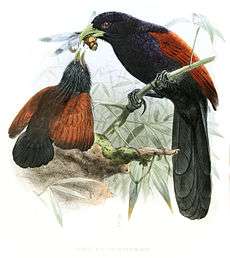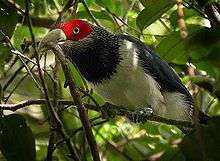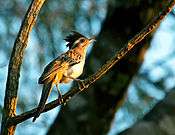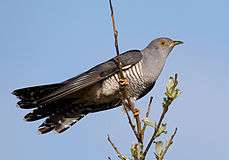List of Cuculiformes by population
This is a list of Cuculiformes species by global population. While numbers are estimates, they have been made by the experts in their fields. For more information on how these estimates were ascertained, see Wikipedia's articles on population biology and population ecology.
This list is incomprehensive, as not all Cuculiformes have had their numbers quantified.
Species by global population
| Common name | Binomial name | Population | Status | Trend | Notes | Image |
|---|---|---|---|---|---|---|
| Black-hooded coucal | Centropus steerii | 70 – 400[1] | CR[1] | |||
| Sumatran ground cuckoo | Carpococcyx viridis | 70 – 400[2] | CR[2] | |||
| Cocos cuckoo | Coccyzus ferrugineus | 350 – 1500[3] | VU[3] | Population is likely towards the low end of this band.[3] | ||
| Banded ground cuckoo | Neomorphus radiolosus | 1000 – 2499[4] | EN[4] |  | ||
| Bay-breasted cuckoo | Coccyzus rufigularis | 2500 – 9999[5] | EN[5] | |||
| Green-billed coucal | Centropus chlororhynchus | 3500 – 15 000[6] | VU[6] | Population is likely towards the low end of this band.[6] |  | |
| Red-faced malkoha | Phaenicophaeus pyrrhocephalus | 3500 – 15 000[7] | VU[7] | A recent study suggests much lower numbers.[7] |  | |
| Sunda coucal | Centropus nigrorufus | 3500 – 15 000[8] | VU[8] |  | ||
| Biak coucal | Centropus chalybeus | 10 000 – 19 999[9] | NT[9] | |||
| Moluccan cuckoo | Cacomantis heinrichi | 10 000 – 19 999[10] | NT[10] | |||
| Short-toed coucal | Centropus rectunguis | 15 000 – 30 000[11] | VU[11] | |||
| Violaceous coucal | Centropus violaceus | 15 000 – 30 000[12] | NT[12] | |||
| Lesser ground cuckoo | Morococcyx erythropygus | 50 000 – 499 999[13] | LC[13] |  | ||
| Pheasant cuckoo | Dromococcyx phasianellus | 50 000 – 499 999[14] | LC[14] |  | ||
| Great spotted cuckoo | Clamator glandarius | 500 000 – 5 000 000[15] | LC[15] | | ||
| Lesser roadrunner | Geococcyx velox | 500 000 – 4 999 999[16] | LC[16] | | ||
| Striped cuckoo | Tapera naevia | 500 000 – 4 999 999[17] | LC[17] |  | ||
| Squirrel cuckoo | Piaya cayana | 5 000 000 – 50 000 000[18] | LC[18] | .jpg) | ||
| Common cuckoo | Cuculus canorus | 25 000 000 – 100 000 000[19] | LC[19] | Preliminary estimate.[19] |  | |
See also
References
- 1 2 3 BirdLife International (2012). "Centropus steerii". IUCN Red List of Threatened Species. Version 2012.2. IUCN. Retrieved 2012-11-28.
- 1 2 3 BirdLife International (2012). "Carpococcyx viridis". IUCN Red List of Threatened Species. Version 2012.2. IUCN. Retrieved 2012-11-28.
- 1 2 3 4 BirdLife International (2012). "Coccyzus ferrugineus". IUCN Red List of Threatened Species. Version 2012.2. IUCN. Retrieved 2012-11-28.
- 1 2 3 BirdLife International (2012). "Neomorphus radiolosus". IUCN Red List of Threatened Species. Version 2012.2. IUCN. Retrieved 2012-11-28.
- 1 2 3 BirdLife International (2012). "Coccyzus rufigularis". IUCN Red List of Threatened Species. Version 2012.2. IUCN. Retrieved 2012-11-28.
- 1 2 3 4 BirdLife International (2012). "Centropus chlororhynchus". IUCN Red List of Threatened Species. Version 2012.2. IUCN. Retrieved 2012-11-28.
- 1 2 3 4 BirdLife International (2012). "Phaenicophaeus pyrrhocephalus". IUCN Red List of Threatened Species. Version 2012.2. IUCN. Retrieved 2012-11-28.
- 1 2 3 BirdLife International (2012). "Centropus nigrorufus". IUCN Red List of Threatened Species. Version 2012.2. IUCN. Retrieved 2012-11-28.
- 1 2 3 BirdLife International (2012). "Centropus chalybeus". IUCN Red List of Threatened Species. Version 2012.2. IUCN. Retrieved 2012-11-28.
- 1 2 3 BirdLife International (2012). "Cacomantis heinrichi". IUCN Red List of Threatened Species. Version 2012.2. IUCN. Retrieved 2012-11-28.
- 1 2 3 BirdLife International (2012). "Centropus rectunguis". IUCN Red List of Threatened Species. Version 2012.2. IUCN. Retrieved 2012-11-28.
- 1 2 3 BirdLife International (2012). "Centropus violaceus". IUCN Red List of Threatened Species. Version 2012.2. IUCN. Retrieved 2012-11-28.
- 1 2 3 BirdLife International (2012). "Morococcyx erythropygus". IUCN Red List of Threatened Species. Version 2012.2. IUCN. Retrieved 2012-11-28.
- 1 2 3 BirdLife International (2012). "Dromococcyx phasianellus". IUCN Red List of Threatened Species. Version 2012.2. IUCN. Retrieved 2012-11-28.
- 1 2 3 BirdLife International (2012). "Clamator glandarius". IUCN Red List of Threatened Species. Version 2012.2. IUCN. Retrieved 2012-11-28.
- 1 2 3 BirdLife International (2012). "Geococcyx velox". IUCN Red List of Threatened Species. Version 2012.2. IUCN. Retrieved 2012-11-28.
- 1 2 3 BirdLife International (2012). "Tapera naevia". IUCN Red List of Threatened Species. Version 2012.2. IUCN. Retrieved 2012-11-28.
- 1 2 3 BirdLife International (2012). "Piaya cayana". IUCN Red List of Threatened Species. Version 2012.2. IUCN. Retrieved 2012-11-28.
- 1 2 3 4 BirdLife International (2012). "Cuculus canorus". IUCN Red List of Threatened Species. Version 2012.2. IUCN. Retrieved 2012-11-28.
This article is issued from Wikipedia - version of the 11/18/2015. The text is available under the Creative Commons Attribution/Share Alike but additional terms may apply for the media files.

